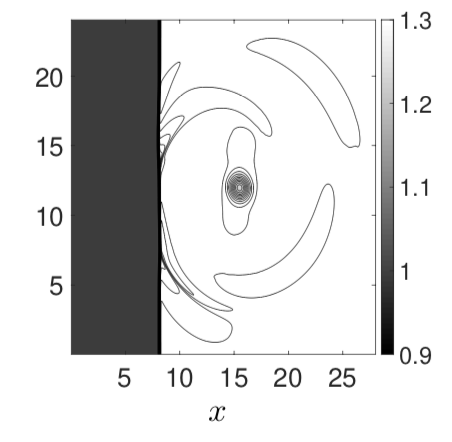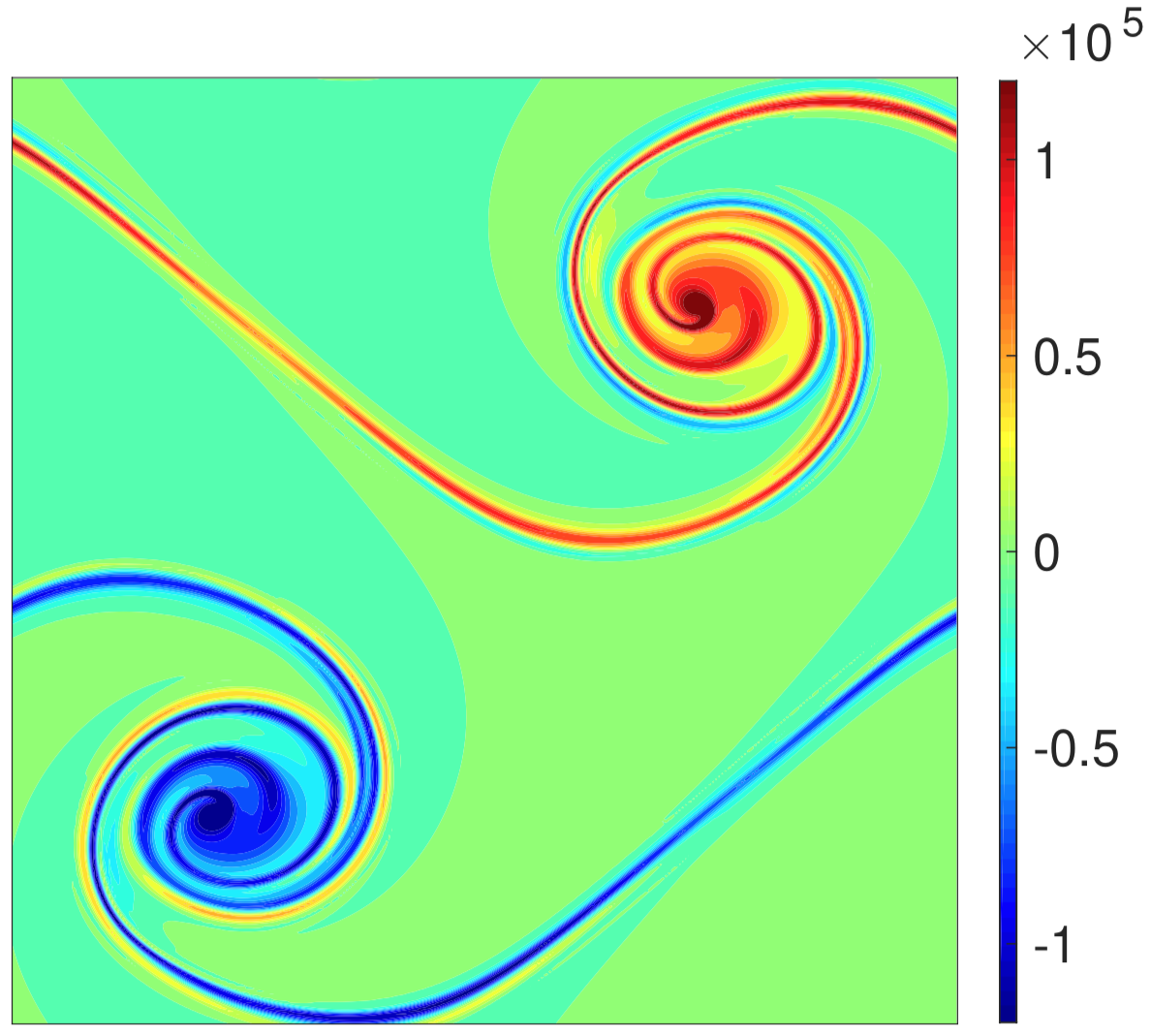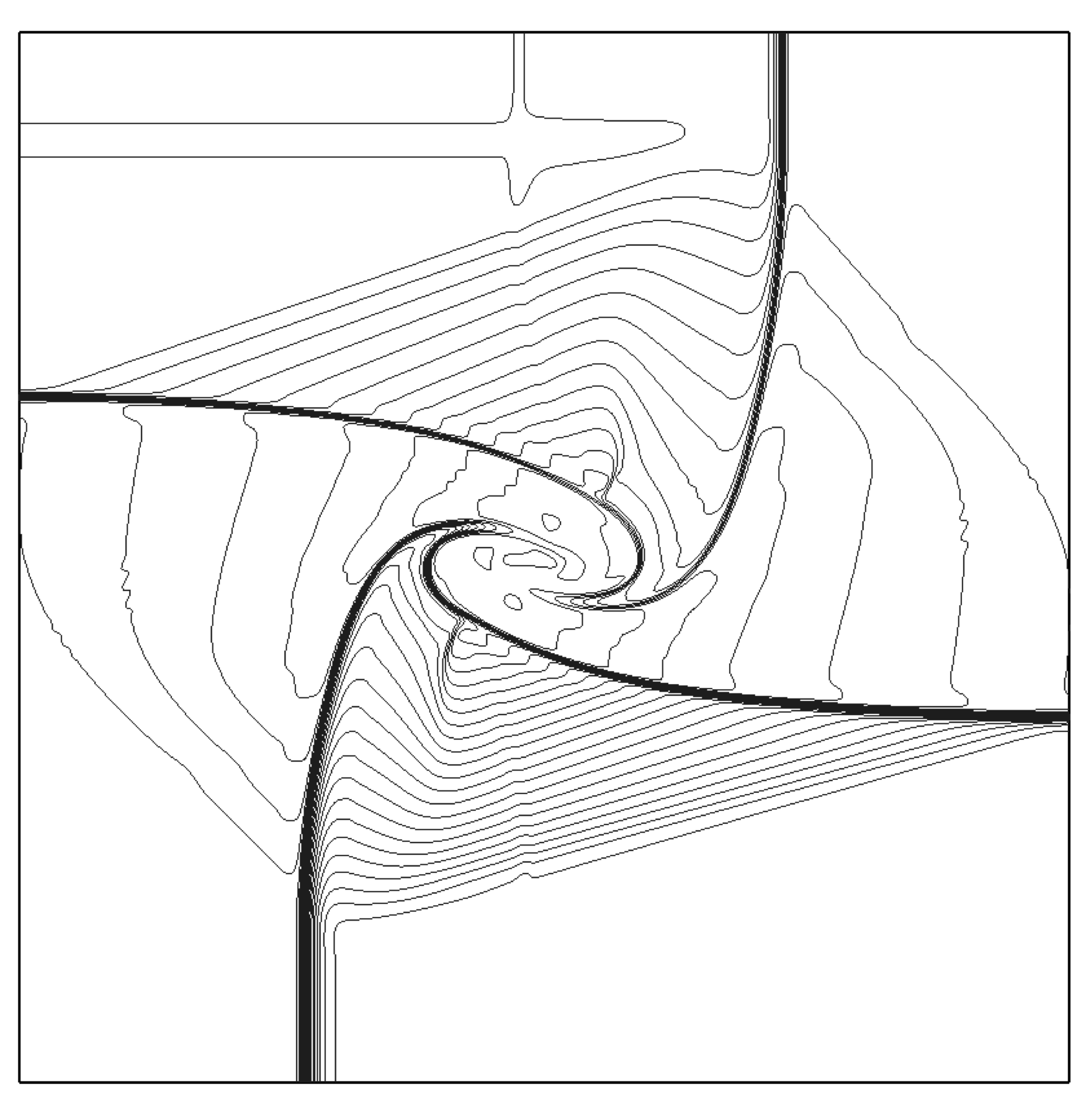Our latest publications are listed below, and can be filtered by research topic as listed under the Research Section.
Toward fully conservative hybrid Lattice Boltzmann Methods for compressible flows (2020)
This article presents a new numerical scheme designed to solve for any scalar equation coupled with a lattice Boltzmann solver (in so- called hybrid methods). Its most direct application is solving an energy equation, in parallel with a lattice Boltzmann solver, dealing with mass and momentum conservation. The numerical scheme is specifically designed to compute the energy flux consistently with the mass and momentum flux (as is carried out, for instance, using Riemann solvers). This scheme effectively eliminates a major limitation of the current compressible hybrid lattice Boltzmann method, in which the energy conservation is tackled under a non-conservative form, leading to discretization errors on jump conditions across shocks. Combined with our recently presented pressure-based solver [G. Farag et al., “A pressure-based regularized lattice-Boltzmann method for the simulation of compressible flows,” Phys. Fluids 32(6), 066106 (2020)], the resulting hybrid lattice Boltzmann scheme is, to the authors’ knowledge, the first to numerically conserve mass, momentum, and total energy simultaneously.
Details
A pressure-based regularized Lattice-Boltzmann method for the simulation of compressible flows (2020)
A new pressure-based Lattice-Boltzmann method (HRR-p) is proposed for the simulation of flows for Mach numbers ranging from 0 to 1,5. Compatible with nearest neighbor lattices (e.g. D3Q19), the model consists of a predictor step comparable to classical athermal Lattice-Boltzmann methods, appended with a fully local and explicit correction step for the pressure. Energy conservation -- for which the Hermitian quadrature is not accurate enough on such lattice -- is solved via a classical finite volume solver based on the entropy equation. The Euler part of the model is then validated for the transport of three canonical modes (vortex, entropy, and acoustic propagation), while its diffusive/viscous properties are assessed via thermal Couette flow simulations. All results match the analytical solutions, with very limited dissipation. Lastly, the robustness of the method is tested in a two-dimensional shock / vortex interaction.
Details
Experimental and numerical Lattice-Boltzmann investigation of the Darrieus-Landau instability (2020)
We present an experimental and numerical investigation of the Darrieus-Landau instability in a quasi two-dimensional Hele-Shaw cell. Experiments and Lattice-Boltzmann numerical simulations are compared with Darrieus-Landau analytical theory, showing an excellent agreement for the exponential growth rate of the instability in the linear regime. The negative growth rate - second solution of the dispersion relation - was also measured numerically for the first time to the authors' knowledge. Experiments and numerical simulations were then carried out beyond the cutoff wavelength, providing good agreement even in the unexplored regime where Darrieus-Landau is supplanted by diffusive stabilization. Lastly, the non-linear evolution involving the merging of crests on the experimental flame front is also successfully recovered using both the Michelson-Sivashinsky equation integration and the Lattice-Boltzmann simulation.
DetailsDiffuse interface modelling of reactive multi-phase flows applied to a sub-critical cryogenic jet (2020)
In order to simulate cryogenic H2−O2 jets under subcritical condition, a numerical model is constructed to solve compressible reactive multi-component flows which involve complex multi-physics processes such as moving material interfaces, shock waves, phase transition and combustion. The liquid and reactive gaseous mixture are described by a homogeneous mixture model with diffusion transport for heat, momentum and species. A hybrid thermodynamic closure strategy is proposed to construct an equation of state (EOS) for the mixture. The phase transition process is modeled by a recent fast relaxation method which gradually reaches the thermo-chemical equilibrium without iterative process. A simplified transport model is also implemented to ensure the accurate behavior in the limit of pure fluids and maintain computational efficiency. Last, a 12-step chemistry model is included to account for hydrogen combustion. Then the developed numerical model is solved with the finite volume method where a low dissipation AUSM (advection upstream splitting method) Riemann solver is extended for multi-component flows. A homogeneous reconstruction strategy compatible with the homogeneous mixture model is adopted to prevent numerical oscillations across material interfaces. Having included these elements, the model is validated on a number of canonical configurations, first for multiphase flows, and second for reactive flows. These tests allow recovery of the expected behavior in both the multiphase and reactive limits, and the model capability is further demonstrated on a 2D burning cryogenic H2−O2 jet, in a configuration reminiscent of rocket engine ignition.
Details
Hybrid regularized Lattice-Boltzmann modelling of premixed and non-premixed combustion processes (2020)
A Lattice-Boltzmann model for low-Mach reactive flows is presented, built upon our recently published model (Comb & Flame, 196, 2018). The approach is hybrid and couples a Lattice-Boltzmann solver for the resolution of mass and momentum conservation and a finite difference solver for the energy and species conservation. Having lifted the constant thermodynamic and transport properties assumptions, the model presented now fully accounts for the classical reactive flow thermodynamic closure: each component is assigned NASA coefficients for calculating its thermodynamic properties. A temperature-dependent viscosity is considered, from which are deduced thermo-diffusive properties via specification of Prandtl and component-specific Schmidt numbers. Another major improvement from our previous contribution is the derivation of an advanced collision kernel compatible of multi-component reactive flows stable in high shear flows. Validation is carried out first on premixed configurations, through simulation of the planar freely propagating flame, the growth of the associated Darrieus-Landau instability and three regimes of flame-vortex interaction. A double shear layer test case including a flow-stabilized diffusion flame is then presented and results are compared with DNS simulations, showing excellent agreement.
DetailsHybrid recursive regularized lattice Boltzmann simulation of humid air with application to meteorological flows (2019)
An extended version of the hybrid recursive regularized Lattice-Boltzmann model which incorporates external force is developed to simulate humid air flows with phase change mechanisms under the Boussinesq approximation. Mass and momentum conservation equations are solved by a regularized lattice Boltzmann approach well suited for high Reynolds number flows, whereas the energy and humidity related equations are solved by a finite volume approach. Two options are investigated to account for cloud formation in atmospheric flow simulations. The first option considers a single conservation equation for total water and an appropriate invariant variable of temperature. In the other approach, liquid and vapor are considered via two separated equations, and phase transition is accounted for via a relaxation procedure. The obtained models are then systematically validated on four well-established benchmark problems including a double diffusive Rayleigh Bénard convection of humid air, 2D and 3D thermal moist rising bubble under convective atmospheric environment as well as a shallow cumulus convection in framework of large-eddy simulation.

Interaction of two-dimensional spots with a heat releasing/absorbing shock wave: linear interaction approximation results (2019)
The canonical interaction between a two-dimensional weak Gaussian disturbance (entropy spot, density spot, weak vortex) with an exothermic/endothermic planar shock wave is studied via the linear interaction approximation. To this end, a unified framework based on an extended Kovásznay decomposition that simultaneously accounts for non-acoustic density disturbances along with a poloidal–toroidal splitting of the vorticity mode and for heat release is proposed. An extended version of Chu’s definition for the energy of disturbances in compressible flows encompassing multi-component mixtures of gases is also proposed. This new definition precludes spurious non-normal phenomena when computing the total energy of extended Kovásznay modes. Detailed results are provided for three cases, along with fully general expressions for mixed solutions that combine incoming vortical, entropy and density disturbances.
DetailsHybrid recursive regularized thermal lattice Boltzmann model for high subsonic compressible flows (2019)
A thermal lattice Boltzmann model with a hybrid recursive regularization (HRR) collision operator is developed on standard lattices for simulation of subsonic and sonic compressible flows without shock. The approach is hybrid: mass and momentum conservation equations are solved using a lattice Boltzmann solver, while the energy conservation is solved under entropy form with a finite volume solver. The defect of Galilean invariance related to Mach number is corrected by the third order equilibrium distribution function, supplemented by an additional correcting term and hybrid recursive regularization. The proposed approach is assessed considering the simulation of i) an isentropic vortex convection, ii) a two dimensional acoustic pulse and iii) non-isothermal Gaussian pulse with Ma number in range of 0 to 1. Numerical simulations demonstrate that the flaw in Galilean invariance is effectively eliminated by the compressible HRR model. At last, the compressible laminar flows over flat plate at Ma number of 0.3 and 0.87, Reynolds number of 105 are considered to validate the capture of viscous and diffusive effects.
Details
A new formulation for two-wave riemann solver accurate at contact interfaces (2019)
This study proposes a new formulation for the Harten, Lax, and van Leer (HLL) type Riemann solver which is capable of solving contact discontinuities accurately but with robustness for strong shock. It is well known that the original HLL, which has incomplete wave structures, is too dissipative to capture contact discontinuities accurately. On the other side, contact-capturing approximate Riemann solvers such as HLL with Contact (HLLC) usually suffer from spurious solutions, also called carbuncle phenomenon, for strong shock. In this work, a new accurate and robust HLL-type formulation, the so-called HLL-BVD (HLL Riemann solver with boundary variation diminishing) is proposed by modifying the original HLL with the BVD algorithm. Instead of explicitly recovering the complete wave structures like the way of HLLC, the proposed method restores the missing contact with a jump-like function. The capability of solving contact discontinuities is further improved by minimizing the inherent dissipation term in HLL. Without modifying the original incomplete wave structures of HLL, the robustness for strong shock has been reserved. Thus, the proposed method is free from the shock instability problem. The accuracy and robustness of the new method are demonstrated through solving several one- and two-dimensional tests. Results indicate that the new formulation based on the two-wave HLL-type Riemann solver is not only capable of capturing contact waves more accurately than the original HLL or HLLC but, most importantly, is free form carbuncle instability for strong shock.
Details